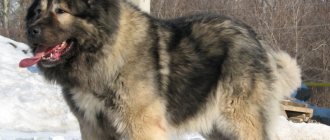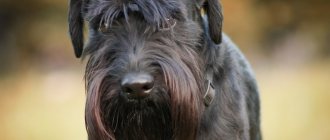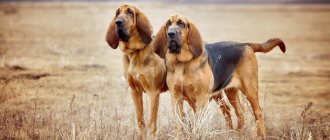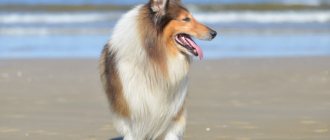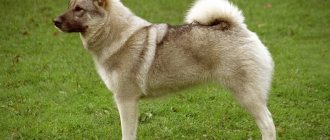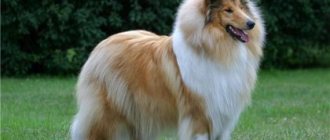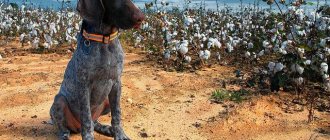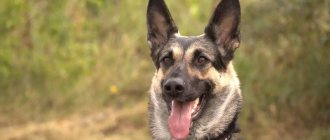The Scottish Shepherd Collie is a herding dog with a centuries-old history. The breed reached its peak of popularity after the release of the film Lassie Comes Home. Since then, many films have been made continuing the adventures of the dog, but in all of them the Scottish Shepherd demonstrated courage and amazing loyalty to people. Collie has become a real symbol of love and friendship between man and dog. Let's figure out why the directors chose this particular breed.
Description of the collie breed
Popularity 141st among 263 dog breeds
Lifespan:
12-14 years old
Breed group:
Shepherd's
Height:
males: 56-61 cm, females: 51-56 cm
Country of origin:
Scotland
Average price:
15-25 thousand rubles
Weight:
males: 26-34 kg, females: 19-26 kg
Latest articles Cat health
Rabies vaccination for cats: choice of vaccine, necessity, schedule 01/22/2022 4 0 0
Selection and adaptation
TOP 20 best cat breeds for families with children 01/22/2022 25 0 0
Dandie Dinmont Terrier
The breed was developed in Scotland by crossing Skye and Bedlington Terriers. Farmers adapted dogs to catch rodents and hunt badgers and foxes. Sensitive dogs notified the owner of the arrival of a stranger and possible danger. The breed was named after the literary hero Dandy Diamond from the novel by Victor Hugo, who kept a whole pack of terriers.
Dandie Dinmont Terriers are small dogs with a long body, short limbs and a fluffy cap on their heads. The standard allows 2 colors:
- Pepper - from pale gray to blue-black with a silver cap.
- Mustard - from light sand to red-brown with a cream-colored cap.
Behind the toy appearance of the Dandie Dinmont Terrier lies an independent, decisive character. On the street, he can provoke a fight with a large dog if he senses danger. The Dandie Dinmont chooses one owner and treats other family members evenly and kindly. Loves to play with children. He behaves warily, even hostilely, with strangers.
Advantages and disadvantages
- Pros:
- loves people, children and pets;
- friendly and non-aggressive;
- moderately active: loves to play and lie on the couch;
- feels good in a small apartment;
- looks luxurious and sophisticated;
- Excellent training for any type of activity except security.
- Minuses:
- complex grooming;
- without socialization and education, he can grow up too cowardly and timid;
- has no protective qualities.
Theses
- This is a smart, obedient, faithful dog. Infinitely devoted to family.
- They come in long-haired and short-haired varieties, both variations require care, but the long-haired variety requires more care.
- Many have drug sensitivities, which veterinarians are usually aware of. However, it is better to warn, since the reaction is unpredictable, including anaphylactic shock and death.
- They love children and play with them, they are a good nanny and friend.
- Clean, they nevertheless collect small debris with their fur during walks.
- They treat strangers with caution, but not aggressively. With proper socialization they are friendly, without it they are shy and timid.
Key facts
The Collie is a beautiful aristocratic dog, despite its working origins. The description of the collie breed says that the dog is very smart and quick-witted.
The Scottish Sheepdog has a wonderful friendly and balanced character. Like most herding dogs, she gets along well with children and animals and becomes an attentive nanny for them. For an adult, a collie will be a good companion.
This breed is highly trainable, but will not work for protection. Sports are more suitable for her.
The characteristics of the collie breed emphasize that they are very healthy animals, real long-livers. However, there are some breed-specific diseases. The lifespan of a collie is on average 13 years.
These animals are unpretentious when it comes to food, which cannot be said about caring for their fur. To keep a collie looking beautiful, you need to brush and wash it regularly, which is not the easiest thing. There is a close relative of the long-haired Scottish Collie - the short-haired variety, but they are not common in our country.
Walks
Collie loves to run in the fresh air. Being locked up for a long time has a negative impact on the dog's behavior. She begins to rush around the house, destroying everything in her path.
Collie loves to play fetch, so it will be great if you can find a place for him to play.
If you are into running, cycling or roller skating, be sure to take your dog with you - she will be very happy about it.
History of the origin of the Scottish Collie
The history of the origin of these dogs is shrouded in mystery; there are many theories about this. It is known for sure that collie comes from Scotland. There are three versions regarding the name itself.
First, the name comes from the breed of black sheep that dogs guarded. The second is from the English word “cole”, which means coal. The third is similar to the second, only “col” is a designation for the color black in one of the Scottish dialects. In any case, it is clear that the dogs were originally black, and for a long time this dominated the color of the collie.
They probably descend from the dogs of the Roman legionnaires who arrived in Scotland in the mid-1st century AD. e., but the ancestors of the collie could have been brought even earlier - by nomads during the Stone Age. For a long time they were used to protect flocks. Those dogs had a completely different appearance, the only thing they had in common with modern collies was long hair, which protected the herding dogs from the cold Scottish winds.
Presumably, in the selection of the breed and bringing it to its modern form, setters, greyhounds and Russian Italian greyhounds were noted. Setters gave the Scottish Sheepdog color (Irish - red, Gordon setter - black and tan), and the Greyhound and Italian Greyhound were used to lighten the bones and lengthen the muzzle.
In 1860, collies were noticed by Queen Victoria, and with her light hand they gained popularity in England and in the world. Scottish Sheepdogs were divided into short-haired, long-haired and short-tailed. They began to be exhibited, and in high society the collies quickly changed their profession from shepherds to companions.
The breed has existed in its usual form since 1885, and the first standard was adopted in 1891. It underwent changes three more times until it acquired its modern appearance in 1962.
In Russia, collies won the heart of Emperor Nicholas II himself, and he brought the first dogs to Russia. His personal kennel housed 11 or 12 dogs, and his favorite was the shepherd dog Iman, who often accompanied the last Russian Tsar on walks.
The exact fate of the nursery after the revolution is unknown, but there is evidence that the animals survived and were used as postal dogs during the Civil War. In the USSR, collies became widespread and were real people's favorites. They reached the peak of popularity in 1974 after the screening of the American TV series Lassie. Nowadays, collies are not so common.
Briefly about the main thing
- Despite the serious size of the breeds, these are not always angry and aggressive dogs.
- The most intelligent herding breed is called the border collie.
- The main functions of the herding group are to protect livestock and accompany their movements.
- The working qualities of such breeds are fast running, loud barking and a wide range of vision.
- It is clear that herding sheep is not a priority task for shepherd puppies today, but no one has canceled their innate skills. When buying such a dog for your home, you need to understand what responsibility the owner bears and how exactly to raise a huge dog.
- Herding breeds are extremely active. If the owner needs a quiet, calm friend and companion, it is better to stick with other dogs.
Appearance of a Scottish Collie
General impression
Collies are classified as sheepdogs and cattle dogs, group 1 according to the FCI classification.
The Collie is a very beautiful, stately dog, full of self-esteem, its appearance is perceived as a single whole. This is a strong and energetic animal with an expressive head. Even the photo of the collie shows that she has a kind and balanced character.
Head
The head is wedge-shaped with smooth outlines, evenly narrowed towards the nose. The size of the head should be in harmony with the size and body of the dog. The muzzle is rounded at the end, never square.
The nose always has black pigment. The eyes are slightly slanted, almond-shaped, brown in all colors except harlequin. The look is attentive, full of intelligence and liveliness.
The ears are erect, small, the tip of the ear can be drooping by ⅓. When the dog is alert, they move forward a little.
The jaw is strong with clearly defined lips. The large teeth are set in a regular scissor bite.
Neck
The neck is well arched, of medium length, muscular.
Torso
The body is rectangular, slightly elongated in length, with light bones, but at the same time with a strong back and deep chest.
Forelegs
The forelimbs are straight, parallel, and do not turn out anywhere. The shoulder angles are clearly defined. The paw is oval, with tightly knit toes.
Hind limbs
The hind legs are well muscled, dry underneath with sinewy hocks and short metatarsals. The articulation angles are clear.
Tail
The tail is long and not raised, with a slight bend, reaching the hock joints. When a dog is happy, it can wave it, but not throw it over its back.
Movement
The movements are characteristic of the breed. The front paws are placed close to each other, but do not cross or intertwine. The hindquarters push well, providing a wide stride. When the collie moves, it should appear as if it is floating.
Wool
The coat is very long and thick, consisting of guard hairs and undercoat. The remaining part is tough and thick. The wavy spine is a flaw. The undercoat is soft and very dense, so that the skin is almost invisible. A luxurious white collar frames the head around the neck. The hair on the muzzle and hind hocks is short. Legs with good feathering. The fur on the tail is very long and fluffy.
Color
Three collie colors are allowed:
- tricolor;
- sable with white points;
- marbled blue or blue merle.
Sable is any red shade, except very light ones, from mahogany to light gold. Sable dogs should have a white collar, white socks or socks, and possibly a white tail tip.
Tricolor is a black pigment with bright tan marks. A liver or brown tint is extremely undesirable.
Blue Merle is a silver-blue color with black spots (but not large ones!) It can be with or without tan. Blue merle dogs are the only ones allowed to have blue eyes or blue specks on brown eyes.
Dimensions
The size of the collie is quite large, the height at the withers of males reaches 56-62 cm, and that of females - 51-56 cm. The weight of the collie, thanks to its lightweight frame, is quite small for its size - about 25-30 kg. It is difficult to determine by the height of the collie whether the dog in front of you is a boy or a girl.
Sheltie
The breed was bred on the Shetland Islands, located northeast of Scotland, hence the second name - Shetland Sheepdogs. The Sheltie's ancestors were dogs that looked like small Spitz dogs. During selection, they were crossed with Scottish longhaired shepherds, Papillons, and spaniels. As a result, the Sheltie inherited the appearance of the Collie, and other breeds influenced the formation of their character.
Longhaired Collie and Sheltie.
At the dawn of the appearance of Shelties, they guarded yards, signaling danger with loud barks, and helped herd short-legged Shetland sheep. Now they have become house companions.
Shelties look like smaller versions of long-haired Scottish Sheepdogs. The height of the dogs does not exceed 39.5 cm, maximum weight is 10 kg. They inherited the colors of their large collie relatives, but added two more to the standard:
- bi-color - a combination of black and white;
- bi-merle - marbled without tan.
Shetland Sheepdogs are often called mini collies, but the temperament and personality of these dogs vary greatly. Shelties are active, nimble dogs that find it difficult to sit still. They follow their owner everywhere and participate in household chores. They treat animals kindly, do not try to dominate, love to “talk” and express emotions with sounds.
It is a mistake to treat the Sheltie as a decorative “sofa” dog. With a lack of movement and mental stress, Shetland Sheepdogs' character deteriorates. They grow up naughty, make a mess in the apartment, and run away on walks. Shelties are among the top ten smartest dogs.
See on topic: The smartest breeds of small dogs.
Character of the Scottish Collie
Collie is an intelligent, sensitive, affectionate dog, completely devoid of aggression. This breed is not suitable as a watchman, property guard or bodyguard, but it is an excellent option for a family. She gets along with other animals even in cramped home conditions; her hunting instincts are not developed. He will take charge of small children and be their “shepherd.”
A collie will never offend a person - he is very devoted to his owner. But in every barrel of honey there is a fly in the ointment, and these dogs also have some shortcomings. Lack of aggression with insufficient and untimely socialization of a puppy can develop into cowardice and timidity in an adult dog.
The Collie is a very active and sociable breed, so it is not suitable for couch potatoes and inactive people, as well as overly busy workaholics. Without communication and affection, the dog suffers greatly.
Representatives of this breed are characterized by excessive “talkativeness”; You will constantly hear barking at home, and instead of a bell, your dog will “ring.”
The character of collies is very proud and touchy; physical punishment should never be used in their upbringing. A separate disadvantage is the need for careful grooming. But the pros of collies outweigh the cons; it is difficult to find a more cheerful and devoted breed.
Dogs of this breed walk a lot; in winter they are also quite comfortable outside due to their thick coat. Collie is suitable for keeping in an apartment and in a private house.
How to choose a herding dog
When choosing a herding puppy, there are several factors to consider:
- In what climate will the dog grow? If it is cold, then choose a breed with a good undercoat. In warm weather - smooth-haired.
- What is a dog for? If you herd a flock of sheep and follow strictly specified commands, then you need one breed. If independent decisions are required from the dog, another one will be required.
- Which breed does the owner like? Maybe the color of an individual puppy caught my eye, or maybe there is a good and familiar shepherd breeder from whom it is better to adopt a dog.
Experienced dog handlers advise buying a puppy only after meeting the dog’s parents in person. It is advisable to look at the father and mother in action, to find out what working qualities they possess. It is better if the puppy has not outgrown 8-10 weeks of age. Already at this time, the “shepherd” can demonstrate his instincts, which it is also better to ask the breeder about.
A separate point needs to be mentioned is the dog’s health. The puppy should not be lethargic. They look carefully at the coat (it should be shiny), eyes (clean), navel and other features. Any talk about bad weather, allergies or overeating should go to another breeder.
The same should be done if animals are spoken of only in superlatives: the smartest, eats everything, understands everything, etc. Each breed and individual, like a person, is individual. This also needs to be taken into account when choosing a dog. After all, a mischievous and active dog is unlikely to suit a calm owner with a measured lifestyle. The owner's temperament is one of the main factors when choosing a breed.
Education and training
Collie is one of the most intelligent and easy to train dogs. They are often chosen as search dogs, rescue dogs, and guide dogs.
Scottish Shepherds pick up commands and exercises on the fly. They quickly understand what is required of them and remember commands. This is a dog that loves to learn. Even with infrequent training, the collie is an excellent learner.
The only nuance in raising and training collies is early socialization. It is necessary to introduce the puppy to other people and dogs, place it in unusual places and circumstances in order to develop a flexible and stable psyche. You cannot use punitive methods in training, otherwise you can achieve the opposite result.
After learning the first commands, you can take a course of OKD training. Collies are very active, light, fast and jumping, so they have found new uses in various sports. They successfully participate in agility, freestyle, frisbee and other gaming competitions.
Much less often than before, collies still perform the herding duties for which they were bred.
Looking for a Collie (Scottish Sheepdog)? Find your pet from 2 offers As a gift
Reviews
If you decide to buy a dog for a child, then you won’t find a better breed. These are the most loyal friends and protectors, good listeners (at least they know how to pretend to listen to you) and caring nannies. Faithful friends and simply charming domestic collies.
Such a dog has many more advantages than disadvantages. This is a good breed. They will become the best friend for the whole family. True, these animals are cowardly; some are terrified of shots, firecrackers, and fireworks.
If you want to make a loyal, non-aggressive friend for a family with cats and dogs, then feel free to adopt a collie. With proper upbringing, you will have a real miracle. I recommend this delightful breed.
Scottish Collie Health and Diseases
Possible diseases
The collie is a very healthy dog, but during the breeding process the breed managed to acquire characteristic diseases. These ailments do not affect all dogs, but you need to keep them in mind.
- Eye diseases. Entropion of the eyelid is corrected surgically. There is also an abnormal breed eye disease that can result in blindness. There are tests to detect this anomaly.
- Ear deafness may occur in marbled-blue animals. There is no cure for deafness.
- Epilepsy is another incurable disease.
- Degenerative myelopathy is a genetic disease. It manifests itself in older dogs initially as loss of coordination and weakness of the hind legs. Within a short time, the hind limbs fail, but the dog does not experience any pain. If she is diagnosed with this, she should stop all training, and if her paws fail, she should buy a wheelchair. There is no treatment, the pet can only receive palliative treatment, and the owner can maintain a good standard of living for his old friend.
- Skin diseases and allergies can be treated with medication; the main thing is to diagnose them correctly.
Collies are not susceptible to infectious diseases, but in order to reduce the risk to almost zero, puppies receive preventive vaccinations, which are repeated for adult dogs once a year.
Reproductive health
The first heat occurs in a Scottish Shepherd bitch at 6-9 months, but she can be bred no earlier than a year and a half and her second heat. Males are untied at approximately two years of age. Mating is arranged on days 9-14 of estrus; after the first mating, a control mating is carried out 1-2 days later.
Pregnancy lasts on average 63 days, or 9 weeks. The pregnancy itself usually proceeds without problems. From the middle of the term, you should limit sports and games with sudden movements, while increasing the duration and length of walking. A pregnant dog needs to add calcium and phosphorus supplements to its food. The bitch is switched to three meals a day after 5-6 weeks.
Childbirth in collies usually occurs without complications. The first days after childbirth, the mother needs increased care. The bitch must not be allowed to become hypothermic; the discharge must be monitored. Do not force her to walk for a long time; in the first days you can only take her out to the toilet.
Healthy and well-fed puppies sleep. Weak and small puppies should be placed close to the chest and care should be taken that they are not pushed aside by stronger brothers.
West Highland White Terrier
The breed was bred in the rocky terrain of western Scotland. Presumably the ancestors were Cairn Terriers. West Highlands skillfully hunted small animals, pulling them out of crevices and holes. Now they have turned into companion dogs. Breeders and owners have shortened the long name of the breed and call them Westies or Westies.
Outwardly, the West Highland White Terrier resembles a plush toy with semi-long snow-white fur, dark beady eyes and neat triangular ears. However, first impressions are deceiving. Westies are stronger, stronger, and more energetic than decorative dogs.
These are inquisitive, noisy fidgets. They don't like loneliness. If there is a lack of attention, they may even refuse to eat. They treat children kindly, but do not tolerate free treatment. They do not get along well with pets, not wanting to share the owner's attention.
Features of feeding and diet
You need to choose what to feed your dog - dry food or natural food. “Drying” is more convenient to use. There is no need to fuss with pots or waste time preparing food. You need to choose high-quality dry food.
You should not feed your pet more than normal, even if the portion seems small to you. This is especially true for high-protein feeds.
Dogs love natural food more and eat it more willingly, but then you need to carefully plan the diet so that there is enough protein, fat, carbohydrates, vitamins and minerals. Foods that should not be given to Scots:
- tubular bones;
- sweets and flour;
- river fish;
- legumes, potatoes;
- fatty meat, lard.
It is not recommended to mix both types of nutrition.
Puppies begin to be fed at 2-3 weeks, they receive six meals a day plus breast milk. Month-old babies should confidently eat from a saucer. Up to seven months, puppies are fed 4-5 times a day, from seven months to 15-18 - three times. An adult needs two meals a day.
What to feed
Colliers should be brushed by lifting the hair up to the base. Take extra care when cleaning the ears, chest, paws and tail because these are the places where he tends to curl. This procedure should be performed daily for at least 15 minutes. Very long hair on the paws, sides and stomach should be trimmed periodically to give the dog an overall pattern. Proper nutrition for your dog is also important.
Scottish shepherds have fairly good health; there are no serious difficulties in shaping their diet. It is important to pay attention to some nuances. Karma should not be oily, it should be adapted to the age of the dog. A one and a half year old puppy needs more food than an adult. During this period, the most intensive increase occurs, and the amount of food consumed decreases.
There are two types of feeding:
- natural;
- Industrial feed.
When choosing the first method, it should be taken into account that the necessary vitamins and microelements should be added to the food that will be chosen by the veterinarian. An adult dog should eat 300-500 g of meat per day. You can add flakes, but not more than 600 g. It is better to give more vegetables. It is also not allowed to feed the dog with what was from the table.
Collies can be given:
- beef;
- Dairy products;
- Eggs;
- liver;
- Herbs;
- pears;
- bird;
- Boiled seafood without bones;
- vegetables;
- apples;
- seeds.
- The diet should be excluded:
- Raw river fish;
- Pearl barley;
- sweets;
- potato;
- meat;
- flour;
- Chocolate;
- impulses;
- poultry and pork;
- Roasted and unripe vegetables.
- Until the second month of life, raw meat should be served in ground form and then finely chopped. Avoid bones by the seventh month of life, do not spoil the bite. Industrial food products are much simpler. They are balanced and contain everything a dog of a given age and race needs. The most important and #8212; choose good food and don't try to save money on animal food.
- Breeders recommend brands such as
- Eukanuba (Netherlands-USA);
- Protuning (Canada);
Care and maintenance
The long-haired dog requires careful grooming. Collie owners have a collection of various combs at home - frequent and rare combs, slickers, brushes, furminators. Brushing should be regular to avoid the fur becoming tangled.
Shedding occurs twice a year, but the bitch also sheds a lot after giving birth.
The dog must be thoroughly washed when soiled or before a show. Paws are washed after every walk. For drying, it is better to use a compressor - the wool dries much faster, the dense undercoat is dried well, without drying out the dog’s fur and skin.
Collies are usually not given haircuts; only the excess hair on the paws is trimmed. Show dogs are groomed to enhance their features.
The nails of dogs that are walked a lot wear down on their own. If this does not happen, they need to be cut about once a month.
Teeth are cleaned every couple of weeks and given “treats” that prevent the formation of plaque and tartar.
Excess hair should be trimmed from the ears and their condition should be checked occasionally. Eyes - wipe and examine. There should be no excessive discharge or redness in the ears or eyes. The rules for the care and maintenance of collies should be strictly adhered to - this is important for maintaining the health of the animal.
Scottish Shepherds love to run and play. They will be happy to chase a ball or a toy, and can be taken jogging or cycling, and in winter - on a ski trip. Collies love snow very much. Many owners note that if they walk with the whole family, the dog tries to herd everyone into one pile - the shepherd’s instincts take effect.
Cairn Terrier
Cairn translated from English means a pile of stones. The dogs received this name for their ability to deftly drive foxes and badgers out of hiding places in rocks inaccessible to humans. Initially, Cairns were considered shorthaired Skye Terriers, until in 1910 they were recognized as an independent breed.
Cairn Terriers are medium-sized dogs up to 33 cm in height with coarse hair. The standard describes 4 colors: wheaten, cream, shades of gray and red. Each suit can have tiger stripes. Black and white coat colors are not allowed.
Kerns are unpretentious, hardy, cheerful dogs with a balanced character. They are in constant motion, ready to play, walk, and communicate for days. They willingly accompany you on trips and travels. Cairn Terriers are vigilant guards and fearless defenders. They do not feel their size; in case of danger, they bravely attack a stronger enemy.
Tips for choosing a puppy
Before buying a puppy, you need to choose a kennel or breeder. You can visit the exhibitions and the kennel itself and look at the living conditions of the dogs. A passionate breeder will be happy to give you full advice about the breed. The nursery must have an RKF license, and the puppies, accordingly, must have a puppy card, which after six months is changed to the RKF pedigree.
Pedigree collie puppies have a veterinary passport with their first vaccinations and a kennel stamp, which is reflected in the documents.
Find a breed forum on the Internet where Scottish Shepherd owners communicate. Usually there are nurseries, a message board for the sale of puppies, and blacklists of unscrupulous breeders and puppy dealers.
If you have decided on kennels, it’s time to decide on the gender of the puppy. The choice depends on your personal preferences, and both females and males have their pros and cons. If gender is not important to you, just take the puppy you like!
It is better to pick up a puppy from its mother at 1.5-2.5 months. Be sure to look at the mother - the bitch must be healthy and strong, only from a healthy animal can you get healthy puppies.
The puppies themselves are playful and active, they should not have parasites, skin diseases, and especially diarrhea or vomiting. Ears, eyes and nose should be clean. Males have a full set of testes.
Don't buy a low price - you may end up with a dirty or sick puppy. Such a child may even be provided with documents, but most likely they will be fake.
Price
Puppies without a pedigree can be purchased for 6,000-10,000 rubles. The price of a collie from a kennel is usually 15,000 rubles or more.
But sometimes you can find a purebred puppy for a fairly reasonable price, for example, if a child has an allergy and the owners are forced to sell the dog.
When buying a collie, you should remember that she will need a lot of your attention, love and care. Beautiful photos of collies are simply captivating. Collie will become your amazing and extremely loyal friend.

